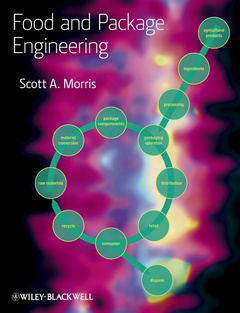Description
Food packaging engineering
Author: Morris Scott A.
Language: English
Subject for Food packaging engineering:
Approximative price 252.56 €
In Print (Delivery period: 12 days).
Add to cart656 p. · Hardback
Description
/li>Contents
/li>
Addressing itself to the variable levels of prior experience that the reader may have, Food Packaging Engineering provides multilevel access to each topic that allows students or professionals of varying backgrounds to find meaningful information and develop technical expertise. Rather than being a simple exposition of technical knowledge, the book provides both real-world examples and challenging problems that require consideration at several different levels. The modular design of the book provides access at three skill or knowledge levels:
1) A general level of experience for those students or readers who are in the field without a rigorous technical background.
2) An intermediate level of experience for those students who are currently at the undergraduate level either as a graduate or in an ongoing curriculum.
3) The advanced level which represents current developments in the field for the advanced student or researcher who is interested in the current state of the art in research and new industrial developments.
Structuring the text in this fashion enables the reader to move from his current level of expertise into higher levels of course material as the reading progresses, rather than simply expanding on a topic at any particular level of expertise.
Bountifully illustrated and meticulously researched, Food Packaging Engineering gives a unique and comprehensive perspective of the field and serves the student or industry professional, whatever level or background, as an outstanding text and reference work for their professional preparation and practice.
The Packaging Cycle.
Food Processing.
The Information Cycle.
Economics, Marketing and Packaging.
Cost Analysis--The Bottom Line.
Fundamental Packaging Functions.
Chapter 2. Engineering Basics.
Abbreviations and Units.
Conservative Engineering.
System Types.
Mass Balances.
Energy Balances.
Thermodynamics.
Mechanics of Materials.
Fluid Flow Systems.
Heat Transfer.
Refrigeration.
Mass Transfer.
Chapter 3. Raw Materials.
Wood and Fiber.
Ceramic Materials.
Metals.
Petrochemicals.
Energy.
Chapter 4. Conversion of Raw Materials to Package Components.
Paper.
Glass.
Steel.
Steel Plastic and Fiber Drums.
Aluminum.
Plastics and Synthetic Polymers.
Biopolymers.
Laminates.
Chapter 5. Secondary Packaging Components.
Caps.
Glues and Adhesives.
Tapes.
Heat Sealing.
Aerosols.
Microwave Packaging.
Printing.
Coding, Scanning and Identification Methods.
Chapter 6. Processing Calculations and Applications.
Thermal Processing.
Aseptic Packaging.
Non-Thermal Processing.
Refrigeration and Freezing of Foods.
Drying of Foods.
Irradiation.
Concentration and Separation of Food Products.
Chapter 7. Food Preservation and Shelf Life.
Deterioration of Food Products.
Chemical Degradation Reactions in Foods.
Environmental Agents.
Gas Permeation and Exposure.
Moisture Related Degradation Reaction.
Package-Product Interaction.
Active Packaging.
Meat and Poultry Products.
Seafoods.
Fresh Fruits and Vegetables.
Dairy Products.
Bakery Products.
Beer and Wine Spoilage.
Chapter 8. Packaging Machinery Filling and Operations.
Machinery Types.
Product Inspection.
Plant Operations.
Production Optimization.
Diagnostic Tools for Quality Management.
Ergonomics.
Chapter 9. Transportation, Distribution and Product Damage.
Energy Efficiency.
Distribution and Warehousing.
Distribution Packaging.
Containerized Transport.
Institutional Packaging.
Response of Packages to Shipping and Handling.
Static Compression Damage.
Dynamic Considerations in Packaging.
The Dynamic Environment of Packaging.
Critical Element Analysis.
Chapter 10. Food Regulation, Safety Systems and Security.
Food and Packaging Regulation History.
Packaging Laws and Their Related Agencies.
HACCP.
Product Recalls.
Food Security.
Chapter 11. Closing the Loop--Disposal, Reuse, Recycling, and the Environment.
Technical Aspects of Package Reuse.
Recycling.
Recycling Regulations.
Disposal and Landfills.
Packaging Waste Programs Outside the United States.
Incineration.
Composting.
Sustainability.
Chapter 12. Future Developments and Technologies.
The Gartner Hype Cycle.
Change and Chaos.
Economic Changes.
Information Technologies.
Connectivity.
Engineering Biological Systems Materials Sciences.
Resource Scarcity.
Changes in the...

